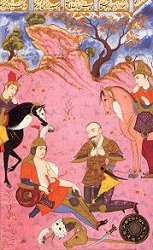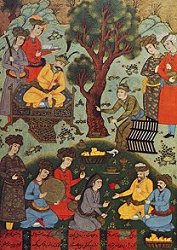 |
The Keianian Dynasty
We now come to what is the first historical, or perhaps semi-historical dynasty, known as the Keianian.
Today there is a family of chiefs in Sistan who claim descent from this illustrious stock,
although... it seems more likely that they are descended from the Saffar Dynasty. In India some of the Parsi
families make the same claim, which is generally conceded.
The first monarch of this dynasty was Kei Kobad [Kei Qobád], a lineal descendant of Manuchehr,
whose retreat was the Alborz range, and who was brought from his place of retirement by Rustam.
The great champion now took the field against the hereditary foe for the first time and covered
himself with glory by defeating Afrasiab in single combat, from which, however,
the Turanian monarch escaped alive because the girdle by which he was held gave way.
Thereafter peace was concluded on equal terms, and it was agreed that the Oxus should remain the
boundary of Iran, as before.
Kei Kaus [Kei Kávus] - to some extent identified with Cyaxares
Kei Kaus, who succeeded his father, invaded Mazandaran against the advice of his councillors, and was
there defeated in a great battle by the Div-i-Sufid [Div-e Sefid] or "White Div"...
During the battle the army was struck with blindness, and it is reasonable to see in this legend a reference
to the eclipse which occurred during the battle between Cyaxares and the Lydians.... This being so, we may
to some extent identify Kei Kobad with Deiokes and Kei Kaus with Cyaxares. But it would be a mistake to press
the matter too far, and there is no resemblance in the name. |
Sohrab [Sohráb] and Rustam
Afrasiab again invaded Persian, and again Rustam was the protagonist. To this Period is assigned the
famous and tragic combat between Rustam and his unknown son...
Siawush [Siávush] and Kei Khusru [Kei Khosroe]
The next incident in the drama is that of Siawush, heir to Kei Kaus,
who deserted his father's court... He took refuge with Afrasiab, who at first received him as an honoured guest.
A few years later, however, false charges were brought against the young prince, and he was executed;
but his infant son Kei Khusru was hidden and ultimately restored to Persia, where he succeeded to the throne. |

"Rustam beside the dying Sohráb"
Shah-nama Ferdowsi |
Kei Khusru [Kei Khosroe]- not Cyrus the Great
Many European writers on Persia, and almost all Persians who have heard of Cyrus the Great,
identify him with Kei Khusru; but the theory, pleasing as it is, cannot stand, for the simple reason
that this Kei Khusru is the Kava Husrava of Indo-Iranian legend, and belongs to a period before the dawn
of history. After several dramatic changes of fortune, Kei Khusru, thanks mainly to Rustam, defeated
Afrasiab. He was taken captive and put to death in revenge for the death of Siawush...
Lohrasp and Gushtasp
Lohrasp, who succeeded Kei Khusru, after ruling for some years, resigned the throne to Gushtasp, who was Zoroaster's royal convert and patron. Again wars with Turan followed, and again Persian forces suffered great reverses, in the course of which Lohrasp, the old king, and Zoroaster were killed at Balkh. |

"Kei Khosroe back from Turan and
Welcomed by Kei Kavus"
Shah-nama Ferdowsi |
Isfandiar
On this occasion Isfandiar, whom his father Gushtasp had imprisoned, came to the rescue and recovered
not only the lost provinces of Persia but also the famous national standard. Isfandiar had been promised
the throne by Gushtasp, who falsely proclaimed his intention of following the example of Lohrasp.
When he claimed it, he was persuaded by his crafty sire to accept the mission of bringing Rustam,
who was alleged to have thrown off his allegiance, to the foot of the throne in bonds.
Again heroic combats ensued, and again the Champion of Persia slew his adversary winning
threby his last great fight. A few years later he fell into a pit prepared by his treacherous
brother and there ended his heroic life.
Bahman or Ardeshir Dirazdast
Gushtasp was succeeded by his grandson Bahman, who is known to history as Artaxerxes Longimanus,
the Latin equivalent of Ardeshir Dirazdast (Ardeshir the Long Arm).
According to Firdausi, this monarch made a speciality of keeping himself informed about affairs
of his empire through secret agents. He was also, according to the same authority, a great conqueror ....
The End of the Heroic Period
Here this description of early Persian history as known to Persians, maybe concluded ....
.... The Heroic period of the history of Iran is mainly legendary, and although towards its close we are dealing with historical personages, it is obscured by the mists of fantastic myth ....
*** |
 |
 |
 |
Heroic Age
( Part 1 ) |
Top of page |
Back to
Heroic Age
( Index ) |
Copyright shall at all times remain vested in the Author.
No part of the work shall be used, reproduced, stored in a retrieval system,
or transmitted in any form or by any means electronic, mechanical, photocopying,
recording or otherwise, without the Author's express written consent.
Copyright ©
2000 K. Kianush, Art Arena
|



